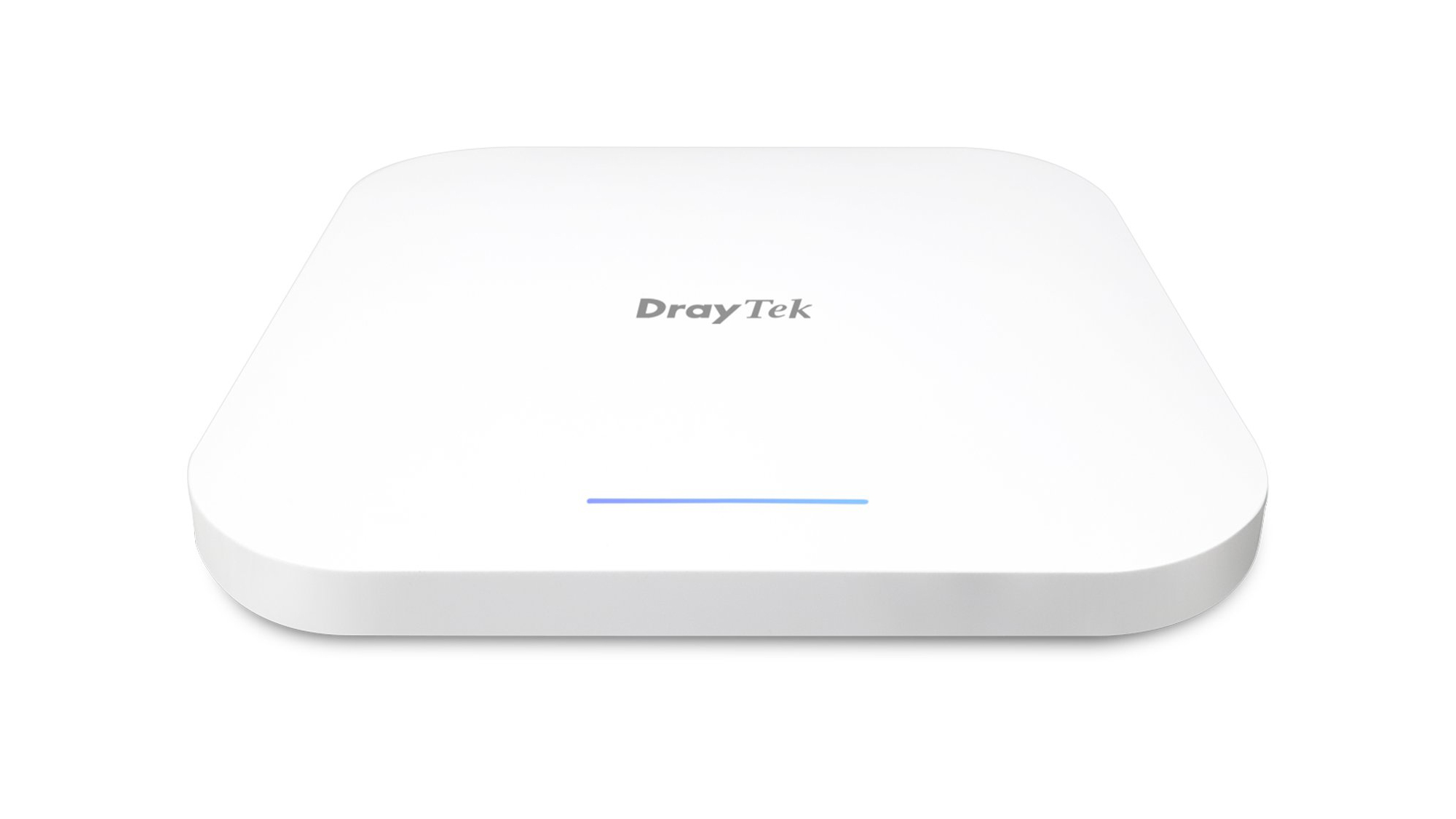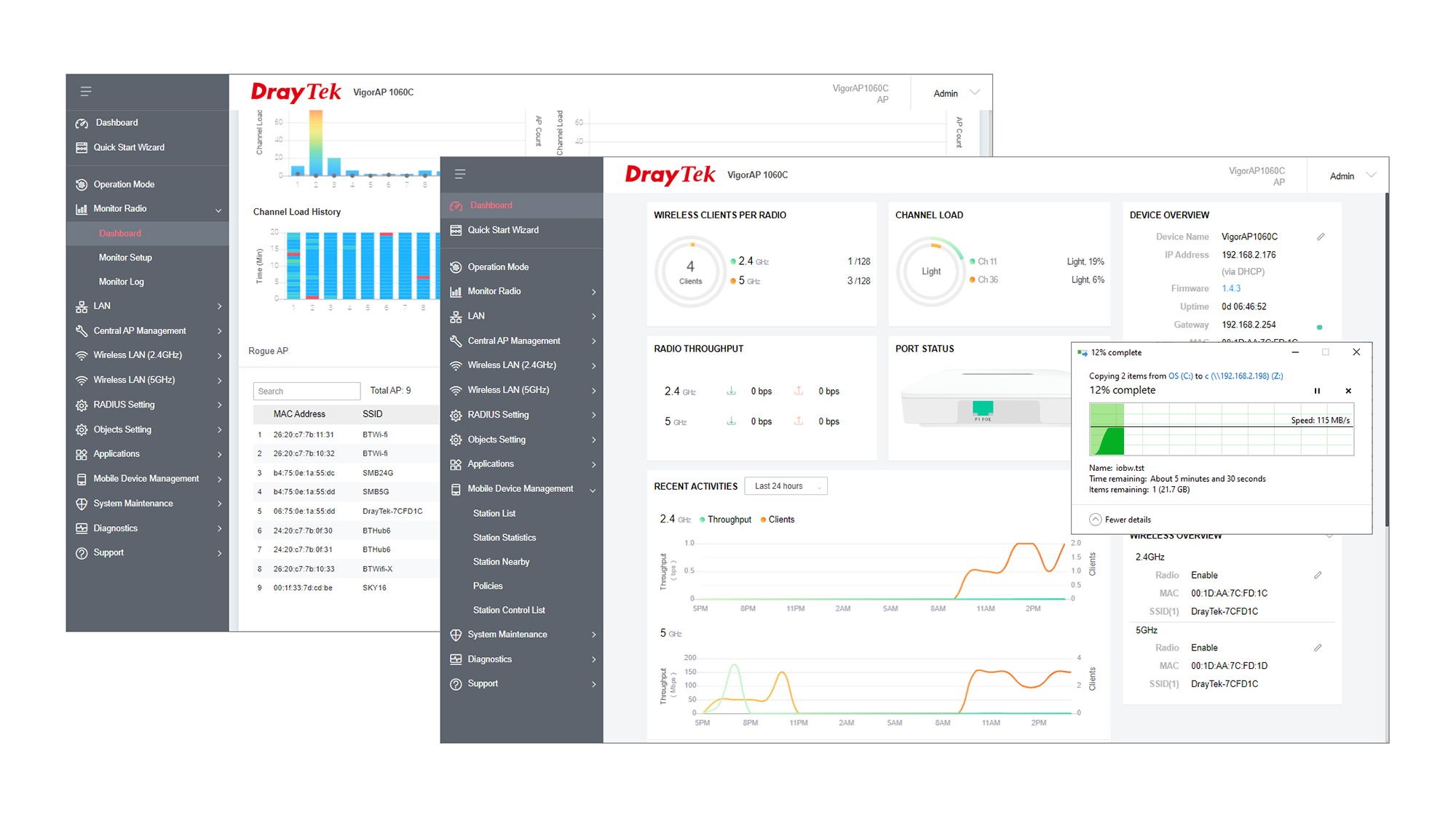DrayTek VigorAP 1060C review: Pedal to the metal
A versatile Wi-Fi 6 AP offering great performance, plenty of management features and smart meshing


-
+
Outstanding speeds
-
+
Smart management options
-
+
Flexible mesh support
-
-
Expensive
-
-
Client OS detection isn’t perfect

DrayTek impressed us last summer with its first Wi-Fi 6 AP, the eminently affordable VigorAP 960C. Now the VigorAP 1060C dials up the performance: its AX3600 rating represents double the bandwidth of the 960C, with its 5GHz radio rated for up to 2,400Mbits/sec along with 1,200Mbits/sec on the 2.4GHz band. A third radio is included too, though this isn’t for client or mesh connections: rather, it’s used for rogue AP detection and 5GHz channel scanning, allowing the main network to dynamically detect and switch to the best available channel.
At the rear, a 2.5GbE uplink port ensures wireless connections aren’t bottlenecked, and it supports PoE+ for single-cable deployment. If you prefer you can use a separate power supply, but this isn’t included in the box – the optional adapter costs £20.
The 1060C is a flexible little thing. It comes with twist-on mountings for ceilings and walls, plus T-rail attachments for suspended ceilings. It can function as a standalone AP, act as a range extender or form part of a self-healing mesh network using DrayTek’s VigorMesh technology. Mesh groups comprise a root AP and up to seven node APs, which can be up to three hops away from the root – offering an easy way to provide coverage over a really broad area. Satellite units can also be connected together via Ethernet for maximum performance and reliability.
Management options are plentiful, too. If you have just one or two 1060C units then you can manage each one from its own web console, or you can auto-provision the units from any DrayTek router that supports the Central AP Management feature. Alternatively, you can centrally manage any number of onsite APs with the free VigorConnect Windows app, while service providers can use the VigorACS cloud service to look after multiple sites.
Setting up a standalone AP is a breeze. The web wizard walks you through setting a strong admin password and creating your first wireless networks; the 1060C can broadcast up to eight SSIDs on each radio, each with its own security settings and optional WPA3 encryption, or you can mix this with WPA2 to keep your legacy clients happy. You can limit the number of clients on each radio or SSID, apply upload and download bandwidth limits, and choose whether to block wireless clients from seeing LAN systems or other wireless users. For added security, it’s even possible to restrict individual SSIDs so that they only accept connections from Windows or macOS clients, or only from mobile devices.

The main dashboard provides plenty of information, including details of active clients and associations, SSID traffic throughput and AP system utilisation.
That third radio comes into its own here, too. On the console’s Radio Monitor page you’ll see a graphical readout of all channel activity, with details of any detected rogue APs. Unrecognised networks with their own SSIDs will be classed as a low-level issue, while anything broadcasting the same network names as the 1060C will be treated as a direct threat. We tested this by configuring a Linksys AP in the lab to use the same SSID as the 1060; as soon as it came online, the 1060C monitor page warned us, and an email alert was fired off too.
Sign up today and you will receive a free copy of our Future Focus 2025 report - the leading guidance on AI, cybersecurity and other IT challenges as per 700+ senior executives
Finally, a station list provides details of all connected wireless clients, with names, uptimes and connection speeds. It will have a stab at identifying their OS too, although we found this didn’t work for all platforms: our Windows workstations were correctly identified, but our iOS and macOS clients came up as unknown.
As for performance, the 1060C excelled in our real-world Wi-Fi 6 tests. Close-range file copies between a Windows 10 Pro workstation with a TP-Link Archer TX3000E Wi-Fi 6 PCI-E adapter and a server on the LAN completed at an average of 107MB/sec; even from ten metres away we got a very creditable 91MB/sec.
The VigorAP 1060C is at the upper end of the price spectrum for a dual-band Wi-Fi 6 AP, but it offers a lot for your money. Performance is impeccable, management choices are extensive and its meshing feature makes it easy to extend your wireless network coverage.
DrayTek VigorAP 1060C specifications
| Band support | AX3600 dual-band 2.4GHz/5GHz 802.11ax |
| Radios | 4 x 4 MU-MIMO, 9 internal aerials (4 x 5GHz, 4 x 2.4GHz, 1 x dual-band RF scanning) |
| Ports | 2.5GbE LAN/PoE+ |
| Additional features | Ceiling/wall mount kit |
| Dimensions (WDH) | 205 x 205 x 33mm |
| Weight | 809g |
Dave is an IT consultant and freelance journalist specialising in hands-on reviews of computer networking products covering all market sectors from small businesses to enterprises. Founder of Binary Testing Ltd – the UK’s premier independent network testing laboratory - Dave has over 45 years of experience in the IT industry.
Dave has produced many thousands of in-depth business networking product reviews from his lab which have been reproduced globally. Writing for ITPro and its sister title, PC Pro, he covers all areas of business IT infrastructure, including servers, storage, network security, data protection, cloud, infrastructure and services.
-
 Trump's AI executive order could leave US in a 'regulatory vacuum'
Trump's AI executive order could leave US in a 'regulatory vacuum'News Citing a "patchwork of 50 different regulatory regimes" and "ideological bias", President Trump wants rules to be set at a federal level
By Emma Woollacott Published
-
 Microsoft Excel is still alive and kicking at 40 – and it's surging in popularity as 82% of finance professionals report ‘emotional attachment’ to the spreadsheet software
Microsoft Excel is still alive and kicking at 40 – and it's surging in popularity as 82% of finance professionals report ‘emotional attachment’ to the spreadsheet softwareNews A recent survey found Gen Z and Millennial finance professionals have a strong “emotional attachment” to Microsoft Excel
By Emma Woollacott Published
-
 LastPass hit with ICO fine after 2022 data breach exposed 1.6 million users – here’s how the incident unfolded
LastPass hit with ICO fine after 2022 data breach exposed 1.6 million users – here’s how the incident unfoldedNews The impact of the LastPass breach was felt by customers as late as December 2024
By Emma Woollacott Published
